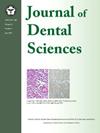2- o -甲基厚朴酚通过糖基化终产物刺激,减轻人类牙龈上皮细胞和成纤维细胞的氧化应激和炎症的产生
IF 3.1
3区 医学
Q1 DENTISTRY, ORAL SURGERY & MEDICINE
引用次数: 0
摘要
背景/目的糖尿病(DM)患者更容易患牙周炎,这主要是由于晚期糖基化终产物(AGEs)的积累,导致氧化应激和炎症。炎症是一种慢性低度炎症和加速细胞衰老的状态,通过ages诱导的细胞衰老和衰老相关分泌表型(SASP)介导,导致牙周退化。2- o -甲基厚朴酚(2-MG)是一种具有抗氧化和抗炎特性的生物活性化合物,在dm相关的牙周变性中仍未得到充分的研究。本研究探讨了2-MG对age诱导的人牙龈上皮细胞(HGEs)和人牙龈成纤维细胞(HGFs)氧化应激和炎症的影响。材料与方法本研究通过评估细胞增殖、创面愈合能力、活性氧(ROS)积累、细胞衰老标志物、白细胞介素(IL)-6、IL-8等SASP因子的分泌来评估2-MG对age刺激的HGEs和hgf的影响。此外,采用Western blot分析检测衰老标志物p16的蛋白表达。结果浓度≤10 μM的2 mg对HGEs和HGFs细胞增殖无显著影响(P >;0.05)。然而,2-MG有效改善了ages诱导的伤口愈合损伤,并以剂量依赖的方式显著减弱了ROS的产生(P <;0.05)。此外,2-MG还能减缓细胞衰老,抑制IL-6和IL-8的分泌(P <;0.05)。Western blot分析显示,2-MG可抑制ages诱导的p16表达(P <;0.05)。结论2-MG可减轻ages诱导的HGEs和HGFs氧化应激和炎症反应。这些结果表明,2-MG可能具有预防或减轻dm相关牙周变性的治疗潜力。本文章由计算机程序翻译,如有差异,请以英文原文为准。
2-O-methylmagnolol mitigates the generation of reactive oxidative stress and inflammaging in human gingival epithelial cells and fibroblasts with advanced glycation end products stimulation
Background/purpose
Individuals with diabetes mellitus (DM) are more susceptible to periodontitis, largely due to the accumulation of advanced glycation end-products (AGEs), which drive oxidative stress and inflammaging. Inflammaging is a state of chronic low-grade inflammation and accelerated cellular aging that contributes to periodontal degradation, mediated by AGEs-induced cellular senescence and senescence-associated secretory phenotype (SASP). 2-O-methylmagnolol (2-MG), a bioactive compound with antioxidant and anti-inflammatory properties, remains underexplored in DM-associated periodontal degeneration. This study investigated the effects of 2-MG on AGE-induced oxidative stress and inflammaging in human gingival epithelial cells (HGEs) and human gingival fibroblasts (HGFs).
Materials and methods
The study assessed the effects of 2-MG on AGE-stimulated HGEs and HGFs by evaluating cell proliferation, wound healing capacity, reactive oxygen species (ROS) accumulation, cellular senescence markers, and the secretion of SASP factors, including interleukin (IL)-6 and IL-8. Additionally, Western blot analysis was performed to examine the protein expression of a senescence marker p16.
Results
Treatment with 2-MG at concentrations up to 10 μM did not significantly affect HGEs and HGFs cell proliferation (P > 0.05). However, 2-MG effectively improved AGEs-induced wound healing impairment and significantly attenuated ROS production in a dose-dependent manner (P < 0.05). Furthermore, 2-MG reduced cellular senescence and suppressed the secretion of IL-6 and IL-8 (P < 0.05). Western blot analysis demonstrated that 2-MG inhibited AGEs-induced p16 expression (P < 0.05).
Conclusion
The findings indicate that 2-MG mitigates AGEs-induced oxidative stress and inflammaging in HGEs and HGFs. These results suggest that 2-MG may have therapeutic potential in preventing or attenuating DM-associated periodontal degeneration.
求助全文
通过发布文献求助,成功后即可免费获取论文全文。
去求助
来源期刊

Journal of Dental Sciences
医学-牙科与口腔外科
CiteScore
5.10
自引率
14.30%
发文量
348
审稿时长
6 days
期刊介绍:
he Journal of Dental Sciences (JDS), published quarterly, is the official and open access publication of the Association for Dental Sciences of the Republic of China (ADS-ROC). The precedent journal of the JDS is the Chinese Dental Journal (CDJ) which had already been covered by MEDLINE in 1988. As the CDJ continued to prove its importance in the region, the ADS-ROC decided to move to the international community by publishing an English journal. Hence, the birth of the JDS in 2006. The JDS is indexed in the SCI Expanded since 2008. It is also indexed in Scopus, and EMCare, ScienceDirect, SIIC Data Bases.
The topics covered by the JDS include all fields of basic and clinical dentistry. Some manuscripts focusing on the study of certain endemic diseases such as dental caries and periodontal diseases in particular regions of any country as well as oral pre-cancers, oral cancers, and oral submucous fibrosis related to betel nut chewing habit are also considered for publication. Besides, the JDS also publishes articles about the efficacy of a new treatment modality on oral verrucous hyperplasia or early oral squamous cell carcinoma.
 求助内容:
求助内容: 应助结果提醒方式:
应助结果提醒方式:


